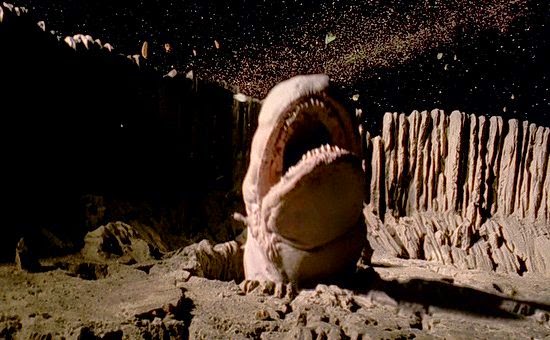 This month’s creature is a titan compared to its modern day cousins, but
compared to its predecessors it was a dwarf. Make no mistake, the titanoboa was
huge - twice as long as the largest anaconda recorded. Unfortunately there is
not a lot known about this snake but I will give you all the information I can
find.
This month’s creature is a titan compared to its modern day cousins, but
compared to its predecessors it was a dwarf. Make no mistake, the titanoboa was
huge - twice as long as the largest anaconda recorded. Unfortunately there is
not a lot known about this snake but I will give you all the information I can
find.
The titanoboa is estimated to have been 12.8m (42ft) long, 0.9m (3ft)
diameter and weigh about 1135kg (2500lb), which is extremely heavy! This makes
it the largest snake ever known, defeating the gigantophis for the title. It
lived 60 to 58 million years ago in the Paleocene era, so after the last
dinosaur extinction. It lived in a tropical warm area which is now South
America.
The titanoboa may have been a snake but with that size it did not have
to be as shy or scared as modern snakes are today. It is believed it hunted
like a crocodile does, mostly under water near banks waiting for its prey and
then striking, wrapping around the victim and constricting it. After it killed
the prey it would begin the process of swallowing it whole like modern snakes
do. Also like modern snakes it could open its jaw wide to swallow large prey.
It would be able to swallow the largest crocodiles alive today with ease, the
titanoboa would kill at an eating contest. It is also believed to have had a
dirt brown colour for its skin to help camouflage itself to with water it
hunted in.
 This titan of a snake was no stranger to danger, it shared the waters
with a super large snapping turtle called carbonemys (which weighed about the
same as titanoboa) and it is believed that these two reptiles battled for
territory. That is a ring match I would pay to see! It is debated a lot about
who would win in a fight, but most people think the titanoboa could not crack
its shell so in the end carbonemys would win by wearing out the opponent.
This titan of a snake was no stranger to danger, it shared the waters
with a super large snapping turtle called carbonemys (which weighed about the
same as titanoboa) and it is believed that these two reptiles battled for
territory. That is a ring match I would pay to see! It is debated a lot about
who would win in a fight, but most people think the titanoboa could not crack
its shell so in the end carbonemys would win by wearing out the opponent.
There has been an exhibit in Grand Central Station, New York about the
titanoboa put on display by the Smithsonian Institute. The exhibit displayed a
life size model in the station designed to “scare the hell out of people” and
promote the Smithsonian TV special “Titanoboa: Monster Snake.” I know it would
make me need to change my underwear if I came around the corner to be face to
face with a titanoboa - and I really like snakes!
With the titanic size of this snake and the idea of it fighting a titan
of a snapping turtle, I nominate the Titanoboa EPIC CREATURE OF THE MONTH! I
really need a monster truck announcer for that.









































-and-Suni.jpg)

